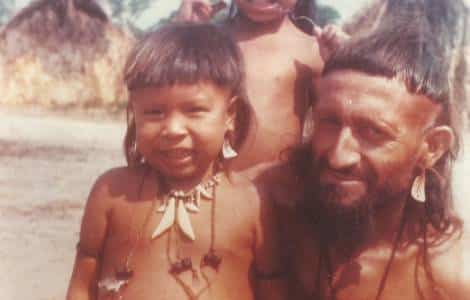The Brazilian judiciary has finally issued an arrest warrant against one of the murderers of Spanish-born Jesuit missionary Vicente Cañas, who was brutally killed 38 years ago in the Amazonian State of Mato Grosso.
Ronaldo Osmar, a local police deputy, was found guilty of killing Cañas in 2017. But it was on this month, though, that the deadline for any kind of legal appeal passed, which means that now Osmar should face the fulfillment of his sentence. Given that he’s old and has been hospitalised, his imprisonment could still depend on his health conditions.
“Such indefiniteness doesn’t bother me. The important thing is that he was convicted and nothing can change that,” Sebastião Carlos Moreira, a pastoral agent of the Bishops’ Conference’s Indigenous Missionary Council (known as CIMI), told <em>Crux</em>.
Born in Albacete, Spain, in 1939, Cañas joined the Society of Jesus and came to Brazil as a missionary in 1966. In 1969, he began working with Indigenous groups in Mato Grosso.
Together with his confrere Fr. Thomaz Aquino Lisbôa, Cañas made the first contacts with the indigenous peoples living in the northwest of Mato Grosso region of Brazil in the 1970s. For more than a decade, Cañas lived with several indigenous peoples (Tapayuna Indians, Paresi, Mÿky and Enawene Nawe), sharing their customs and traditions, <mark style="background-color:rgba(0, 0, 0, 0)" class="has-inline-color has-vivid-cyan-blue-color"><a href="https://www.fides.org/en/news/63226-AMERICA_BRAZIL_The_case_of_the_assassination_of_missionary_Vicente_Canas_defender_of_the_indigenous_reopens">reports</a> </mark><em>Agenzia Fides</em>, the information service of the Pontifical Mission Societies since 1927.
He also helped defend indigenous lands from landowners who wanted to take away their lands and fought with the Brazilian government to establish an official demarcation, which was achieved after his violent death.
“We first met in 1978. At that point, he [Cañas] had already established contact with the Enawenê-Nawê a few years before,” Moreira recalled.
Until then, the Enawenê-Nawê didn’t have real contact with the surrounding society. Their traditional lands hadn’t been recognised by the government and ranchers and loggers invaded their territory.
Cañas lived with them for 10 years, learning their language and habits. He became part of the work group that would present to the government the parameters for the definition of their territory.
“Of course, ranchers were very interested in their lands. Seeing Cañas’s work for their protection, they quickly began targeting him and threats became common,” Moreira recalled.
At a certain point, Cañas himself would warn his friends that his life was in danger. Indeed, in April of 1987, he ended up being killed in his hut, 37 miles away from the Enawenê-Nawê village. He was there alone, in quarantine – when visiting communities separated from the rest of the world, "outsiders" need to first quarantine before seeing them to avoid introducing pathogens to which the communities would have no resistance to – waiting to join them once again. His body was found only 30 days after the murder.
With his death, a long wait for Justice would begin. The problem is that the police inquiry into his murder was headed by deputy Ronaldo Osmar, who was a major suspect. He would do everything he could to cause delays and impede the investigation to go on.
A bizarre chapter of the inquiry occurred in 1989. Cañas’s body had already been examined by forensic experts in Mato Grosso state, but for some reason his skull was sent for further analysis in Minas Gerais State. There, it was declared missing. The skull would be found on the street later, inside of a small box, by a shoeshine boy.
“While the process was being conducted by the local justice, [the case] didn’t move. That’s why we fought for its federalisation,” said Moreira.
One of the reasons for its transfer to federal justice was the fact that Cañas was representing the Brazilian government as a member of the Enawenê-Nawê land grant work group. The new suit started in 2015 and resulted in Osmar’s conviction two years later.
According to CIMI, one of the key elements for the jury was the participation as witnesses of members of the Rikbaktsa Indigenous group. The Enawenê-Nawê people have a cultural interdiction that impedes them to mention dead people, so they weren’t able to talk about Cañas in court. The Rikbaktsa agreed to do so and provided new evidence.
As the legal process dragged on, among the Amazonian Church, Cañas would quickly become a major martyr, side by side with other missionaries who lost their lives in land disputes in the region, like US-born Sister Dorothy Stang (1931-2005) and Father Josimo Tavares (1953-1986). During the Synod for the Pan-Amazon region (2019), he was recalled by many of his friends on several occasions.
“He was a very humane person. He would never conform to any kind of injustice. He had the utopia that we would build a fraternal world and died for it,” Sebastião Moreira said. “For me, he was a model in the way he conducted his life and his faith.”
Among the Enawenê-Nawê, Cañas has never been forgotten. Tragically, part of his struggle was for the demarcation of their lands in the region of Preto River, an ancestral territory where the spirits of three of the group’s clans are thought to inhabit. Such an area is now occupied by farms.
“Part of the lands officially granted to them [in 1996] are now invaded by ranchers and illegal loggers,” Moreira said.
Some of Cañas’s Jesuit colleagues said Justice will only be served in his case when invasions like that cease to happen in Brazil. Unfortunately, that seems to be an even more distant scenario.
<em>Photo: Jesuit missionary Vicente Cañas with indigenous child (image from fides.org).</em>



